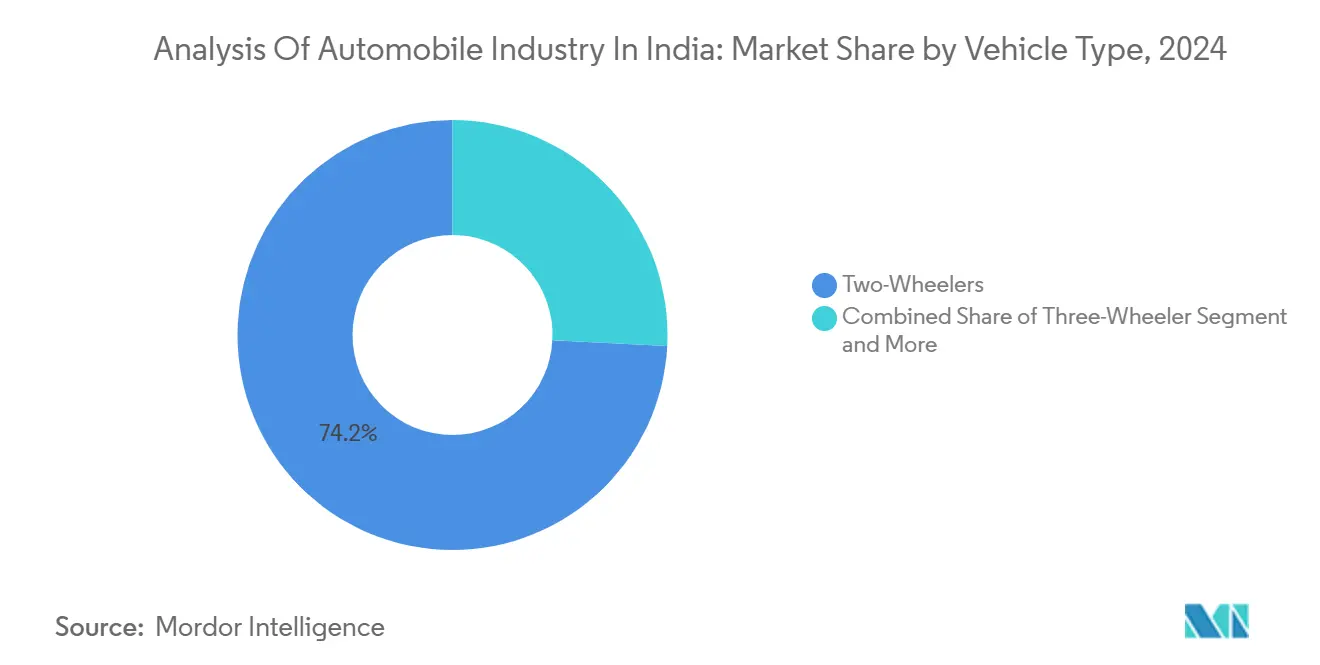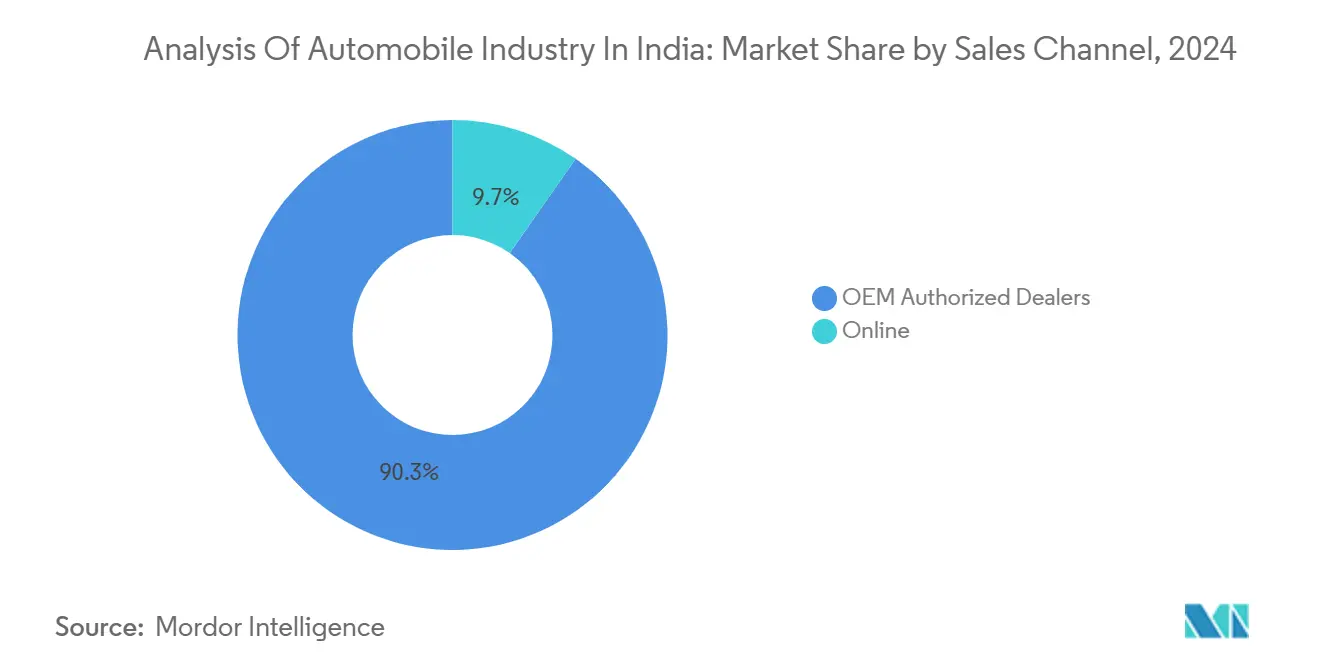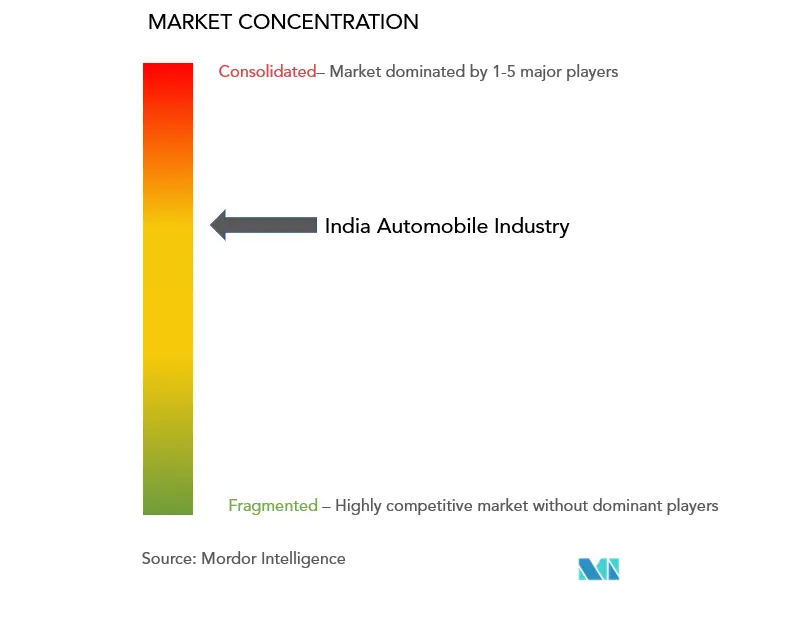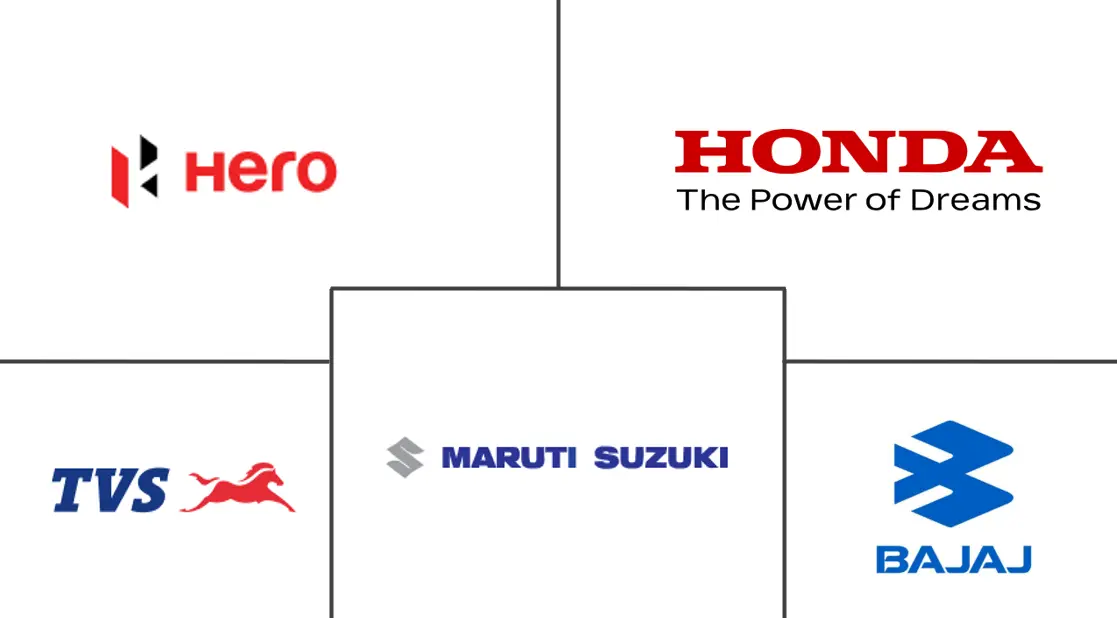
India Automobile Industry Analysis by Mordor Intelligence
The India automobile market size stood at USD 137.06 billion in 2025 and is forecast to reach USD 203.25 billion by 2030, registering an 8.2% CAGR. Demand is buoyed by population‐led consumption, rising household incomes, policy-backed electrification, and a manufacturing base that produced 28.43 million vehicles in FY 2024[1]“Automobile Industry in India,”, Invest India, investindia.gov.in. Sustained output across two-wheelers, passenger cars, commercial vehicles, and three-wheelers keeps the sector resilient, while infrastructure programs such as Pradhan Mantri Gram Sadak Yojana widen geographic reach. Competitive dynamics remain intense, yet opportunities persist in electric models, subscription ownership, and corporate fleet decarbonization. Semiconductor self-reliance, rural road density, and digital retail are additional levers set to lift the India automobile market through the decade.
Key Report Takeaways
- By vehicle type, two-wheelers captured 74.18% of India automobile market share in 2024; passenger cars are advancing at the fastest 9.21% CAGR to 2030.
- By fuel type, petrol vehicles accounted for 59.81% of the India automobile market size in 2024, whereas battery electric vehicles are forecast to register a 10.32% CAGR between 2025 and 2030.
- By sales channel, OEM-authorized dealerships retained 90.28% share of the India automobile market in 2024, yet online sales are set to climb at a 9.52% CAGR through 2030.
- By ownership, personal vehicles commanded 76.52% of India automobile market size in 2024, while commercial fleets are expanding at a 9.53% CAGR to 2030.
- By region, North India led with 32.38% revenue share of the India automobile market in 2024, while South India is projected to grow at a 9.52% CAGR through 2030.
India Automobile Industry Trends and Insights
Drivers Impact Analysis
| Driver | (~) % Impact on CAGR Forecast | Geographic Relevance | Impact Timeline |
|---|---|---|---|
| Rising Disposable Incomes and Rapid Urbanization | +1.5% | Nationwide; Tier-2 cities | Medium term (2-4 years) |
| Government EV and FAME-II Incentives | +1.2% | Metropolitan clusters | Short term (≤2 years) |
| Expansion of National Highway and Rural Road Network | +1.0% | Rural corridors | Long term (≥4 years) |
| Subscription-based Ownership and Leasing | +0.8% | Urban premium markets | Medium term (2-4 years) |
| Local Semiconductor Fabrication Investments | +0.7% | Tamil Nadu, Gujarat hubs | Long term (≥4 years) |
| Corporate Fleet-decarbonization Mandates | +0.6% | Industrial corridors | Medium term (2-4 years) |
| Source: Mordor Intelligence | |||
Rising Disposable Incomes and Rapid Urbanization
Income growth is enlarging the consumer base for the Indian automobile market, especially in Tier-2 and Tier-3 cities, where land availability and lower congestion make vehicle ownership attractive. Sixty-five percent of the population is under 35, aligning prime earning years with first-time purchases. Migration from rural districts stimulates dual demand, urban buyers seek mobility, while remittances finance upgrades back home. The spread of suburban employment hubs reduces dependence on mass transit and supports two-wheelers and compact cars. Subscription programs extend access by sidestepping hefty down payments, further deepening penetration.
Government EV and FAME-II Incentives
India's FAME (Faster Adoption and Manufacturing of Hybrid & Electric Vehicles) Scheme Phase-II, launched in 2019, comes with a hefty budget of INR 11,500 crore (USD 1.31 billion), set to span five years. This initiative aims to boost the sales of electric vehicles, covering e-2Ws, e-3Ws, and e-4Ws. [2]“Annual Report 2025,”, Ministry of Commerce & Industry, commerce.gov.in. State add-ons in Tamil Nadu and Gujarat enhance regional differentials, while the planned FAME-III revision aims to broaden support into heavier segments. These incentives shorten payback periods, encouraging personal buyers and fleet operators to pivot toward zero-emission models.
Expansion of National Highway and Rural Road Network
Connecting more than 159,000 habitations has raised non-farm employment and improved freight efficiency[3]“Rural Roads Project Impact Evaluation,”, World Bank, worldbank.org. Improved roads shorten transit times, lessen vehicle wear, and expand dealer catchment areas, thereby significantly bolstering the long-term outlook for India's automobile market. These advancements not only enhance accessibility for dealers but also create opportunities for market penetration in previously untapped regions. Furthermore, better road infrastructure facilitates smoother transportation of goods, reducing delays and ensuring timely deliveries. Additionally, manufacturers benefit from streamlined logistics, which improve supply chain efficiency and enhance their cost competitiveness both domestically and in export markets. This infrastructure development also supports the growth of ancillary industries, such as auto components and logistics services, further strengthening the overall ecosystem of the automobile market in India.
Subscription-Based Ownership and Leasing Models
Digitally native consumers are prioritizing flexibility instead of outright ownership. With app-based subscriptions, users enjoy month-to-month access, which conveniently includes insurance, service, and roadside assistance. This model allows OEMs to capture lifecycle revenue and provides valuable data that informs design iterations and predictive maintenance services. Additionally, it enables OEMs to build stronger customer relationships by offering tailored services and fostering brand loyalty. The key to scaling this model lies in managing residual values and ensuring liquidity in the secondary market, a feat currently bolstered by partnerships between carmakers and global leasing giants.
Restraints Impact Analysis
| Restraint | (~) % Impact on CAGR Forecast | Geographic Relevance | Impact Timeline |
|---|---|---|---|
| Regulatory Changes, Safety Standards and GST Shifts | -1.2% | Nationwide | Short term (≤2 years) |
| Global Semiconductor Supply-chain Volatility | -0.8% | Key manufacturing hubs | Medium term (2-4 years) |
| Urban Congestion-driven Usage Restrictions | -0.6% | Major metros | Medium term (2-4 years) |
| Rising Telematics-linked Insurance Premiums | -0.4% | Urban fleets | Short term (≤2 years) |
| Source: Mordor Intelligence | |||
Regulatory Changes, Safety Standards and GST Shifts
As India implements BS-VII norms and mandates safety gear, small assemblers grapple with costly powertrain upgrades and validations, squeezing their model margins. These upgrades require significant research and development investments and rigorous testing to meet compliance standards. Meanwhile, GST realignments on components introduce pricing uncertainties, impacting the overall cost structure for manufacturers. Adding to the challenge, varying state road-tax regimes complicate compliance, as manufacturers must navigate differing tax policies across regions. These factors lead to noticeable price hikes for consumers, potentially delaying their purchases and dampening immediate demand in the Indian automobile market. Additionally, the increased costs may push manufacturers to explore alternative strategies, such as the localization of components, to mitigate the financial burden.
Global Semiconductor Supply-Chain Volatility
Even with diversification efforts, lead times for automotive-grade microcontrollers continue to be prolonged, creating significant challenges for manufacturers to meet demand efficiently and maintain production schedules. The sector's limited global bargaining power further complicates secure allocations, making it increasingly difficult to negotiate favorable terms with suppliers or ensure consistent supply. The heavy reliance on overseas wafer fabrication exposes local plants to vulnerabilities, such as logistical delays, geopolitical tensions, or supply chain disruptions, which can severely impact operations. While inventory buffers act as a safeguard to maintain production continuity by ensuring a steady supply of components, they also lead to increased working-capital requirements. This, in turn, compresses profitability and places additional financial strain on manufacturers until domestic fabrication capacity is expanded to address these challenges and meet the growing demand effectively.
Segment Analysis
By Vehicle Type: Two-Wheelers Sustain Dominance Despite Premium Shift
In the Indian auto market, two-wheelers reign supreme, commanding a significant 74.18% share. This dominance highlights the preference for two-wheelers among Indian consumers, driven by factors such as affordability, fuel efficiency, and ease of navigation in congested urban areas. Although smaller, passenger cars are posting the swiftest 9.21% CAGR on the back of SUV and crossover launches tuned to aspirational middle-class tastes. Scooter sales climbed 21% versus the motorcycle segment’s 10% gain, highlighting urban preference for automatic transmissions and ease of use.
Growth momentum continues as electric two-wheelers enter mainstream price points and as financiers extend longer tenures to first-time buyers. Conversely, commercial vehicles hinge on infrastructure budgets and industrial output cycles but benefit from ongoing highway upgrades. Three-wheelers retain relevance for last-mile goods and passenger movement in Tier-2 centers. Regulatory emission upgrades funnel investments toward modular platforms, potentially elevating scale efficiencies for incumbents in the Indian automobile market.

Note: Segment shares of all individual segments available upon report purchase
By Fuel Type: Electrification Accelerates Despite ICE Dominance
Petrol engines retained 59.81% of the India automobile market share in 2024, buoyed by refinery capacity and lower purchase prices relative to diesel. Battery electric vehicles, though smaller in volume, are advancing at a 10.32% CAGR thanks to tax rebates, FAME-II subsidies and falling lithium-ion cell costs. Hybrids bridge range-anxiety gaps, offering efficiency gains without new-energy infrastructure dependence.
Policy commitments to domestic power generation and stricter fuel-economy norms will gradually shift OEM portfolios toward electrified drivetrains. LPG/CNG use expands in commercial fleets seeking operating-cost relief. Meanwhile, fuel-cell technology remains exploratory due to hydrogen supply gaps. Charging-network rollouts and battery-swapping pilots dictate adoption pace but indicators already point to accelerating consumer acceptance across segments in the India automobile market.
By Sales Channel: Digital Transformation Reshapes Distribution
Authorized dealerships still handled 90.28% of 2024 transactions, reflecting entrenched trust and after-sales service networks. Online platforms, however, are scaling at a 9.52% CAGR as digital-first buyers pursue transparent pricing and home delivery. Electric-vehicle makers push direct-to-consumer storefronts that compress costs and deliver end-to-end brand control.
Traditional retailers respond by integrating virtual showrooms, click-to-book tools, and doorstep test drives. Due to connectivity gaps and personal relationship expectations, rural reach hinges on physical outlets. Over time, omnichannel hybrids will dominate, blending digital discovery with tactile verification to secure loyalty in the India automobile market.

Note: Segment shares of all individual segments available upon report purchase
By Ownership Type: Commercial Segment Drives Growth Acceleration
Personal users formed 76.52% of the Indian automobile market in 2024, mirroring the cultural value attached to vehicle possession. Commercial demand, growing at 9.53% CAGR, is powered by e-commerce fulfillment, ride-sharing expansion, and the formalization of logistics SMEs. Government incentives and accelerated depreciation schedules strengthen fleet business cases, especially for electric light commercial vehicles that clock high daily mileage.
Telematics, route optimization, and predictive maintenance lift fleet utilization and depress per-kilometer costs, reinforcing a shift toward organized operations. Subscription fleets blur traditional personal–commercial boundaries by offering vehicle access over ownership, widening service revenue streams for OEMs.
Geography Analysis
North India delivered 32.38% of 2024 revenue for the India automobile market, anchored by the National Capital Region’s manufacturing and administrative influence. Proximity to policy centers and a dense supplier base grant scalability, yet stringent congestion and emission controls could temper volume expansion ahead. Dealer saturation prompts OEMs to pivot toward digital sales and rural catchments within the region.
South India is projected to clock the fastest 9.52% CAGR to 2030, leveraging Tamil Nadu’s integrated supply chain, skilled labor pool, and seaport access. Early adoption of charging corridors and dedicated EV policies accelerates electrification, positioning the south as a proving ground for new-energy platforms. R&D investments in Chennai and Bengaluru foster technology spillovers that enhance local product sophistication.
West India, led by Maharashtra and Gujarat, combines diversified industry, export-ready ports, and investor-friendly regulations to attract fresh capacity. Gujarat’s low-cost power and single-window clearances lure marquee projects from domestic and global automakers. East India trails in per-capita income and infrastructure, yet offers untapped volume potential once connectivity upgrades materialize. Across geographies, decentralizing economic growth disperses demand, compelling OEMs to recalibrate inventory, financing and service models to suit local preferences.
Competitive Landscape
Major Players Maruti Suzuki, Hyundai, Tata Motors, Mahindra & Mahindra, Kia, and Toyota—command a significant share of unit sales, conferring procurement leverage and brand visibility that raise entry hurdles. Maruti Suzuki extends cost leadership through lightweight platforms and vendor co-location, whereas Hyundai targets design and feature differentiation. Tata Motors scales modular EV architectures across passenger and commercial lines, extracting synergies in battery sourcing.
Platform sharing, standard drivetrains, and software-defined features underpin cost reduction and faster model cycles. Chinese-origin challengers such as MG Motor and BYD exploit electric expertise and aggressive pricing to chip away at premium niches. Strategic investments in domestic semiconductor design, battery joint ventures, and flexible manufacturing aim to secure long-term resilience for incumbents.
Mergers, technology alliances, and capacity expansions punctuate the competitive narrative. Toyota’s tie-up with Suzuki pools hybrid know-how, while Mahindra partners with Volkswagen’s MEB platform to accelerate BEV rollout. Across the Indian automobile market, data monetization, over-the-air upgrades, and service subscriptions emerge as future revenue pillars.
India Automobile Market Leaders
-
Hero MotoCorp
-
Honda
-
TVS Motor Company
-
Maruti Suzuki
-
Bajaj Auto
- *Disclaimer: Major Players sorted in no particular order

Recent Industry Developments
- July 2024: Tata Motors introduced the Curvv SUV in both ICE and electric trims, widening its presence in the fastest-growing passenger category.
- July 2024: Toyota Kirloskar inked an agreement with Maharashtra for a new plant, underscoring continued Japanese commitment to the India automobile market.
- February 2024: TVS Mobility, part of the TVS Group, has forged a strategic alliance with Mitsubishi Corporation, a leading Japanese conglomerate. Mitsubishi has pumped INR 300 crore (USD 40 million) into TVS Vehicles Mobility Solutions (TVS VMS), a newly minted subsidiary of TVS, securing a 32% stake in the process.
India Automobile Industry Report Scope
The Indian automobile industry encompasses the manufacturing, marketing, and sale of vehicles within India, including passenger cars, commercial vehicles, two-wheelers, and three-wheelers.
The Indian automobile industry is segmented by vehicle types (two-wheelers, passenger vehicles, commercial vehicles, and three-wheelers), by fuel type (diesel, petrol/gasoline, electric, CNG/LPG, and others), and by region (North India, East India, West India, and South India). The report covers the market size and forecast for the Indian automobile industry in value (USD) for all the above segments.
| Two-wheelers |
| Three-wheelers |
| Passenger Cars |
| Commercial Vehicles |
| Petrol / Gasoline |
| Diesel |
| LPG / CNG |
| Battery Electric Vehicles |
| Hybrid Electric Vehicles |
| Plug-in Hybrid Electric Vehicles |
| Fuel-Cell Electric Vehicles |
| OEM-Authorised Dealers |
| Online |
| Personal Use |
| Commercial Use |
| North India |
| South India |
| East India |
| West India |
| By Vehicle Type | Two-wheelers |
| Three-wheelers | |
| Passenger Cars | |
| Commercial Vehicles | |
| By Fuel Type | Petrol / Gasoline |
| Diesel | |
| LPG / CNG | |
| Battery Electric Vehicles | |
| Hybrid Electric Vehicles | |
| Plug-in Hybrid Electric Vehicles | |
| Fuel-Cell Electric Vehicles | |
| By Sales Channel | OEM-Authorised Dealers |
| Online | |
| By Ownership Type | Personal Use |
| Commercial Use | |
| By Region | North India |
| South India | |
| East India | |
| West India |
Key Questions Answered in the Report
What is the projected value of the India automobile market by 2030?
The India automobile market is forecast to reach USD 203.25 billion by 2030.
Which vehicle type is growing fastest in India?
Passenger cars are expanding at a 9.21% CAGR through 2030, making them the fastest-growing category.
Why is South India important for automakers?
South India offers integrated supply chains, skilled labor and EV-friendly policies, supporting a 9.52% regional CAGR to 2030.
How dominant are electric vehicles in India’s fuel mix?
Battery electric vehicles currently hold a modest share but are rising at a 10.32% CAGR owing to subsidies and charging build-out.
What challenges could slow market growth?
Tougher emission norms, semiconductor shortages and urban congestion policies may trim the market’s CAGR in the near term.
Page last updated on:



